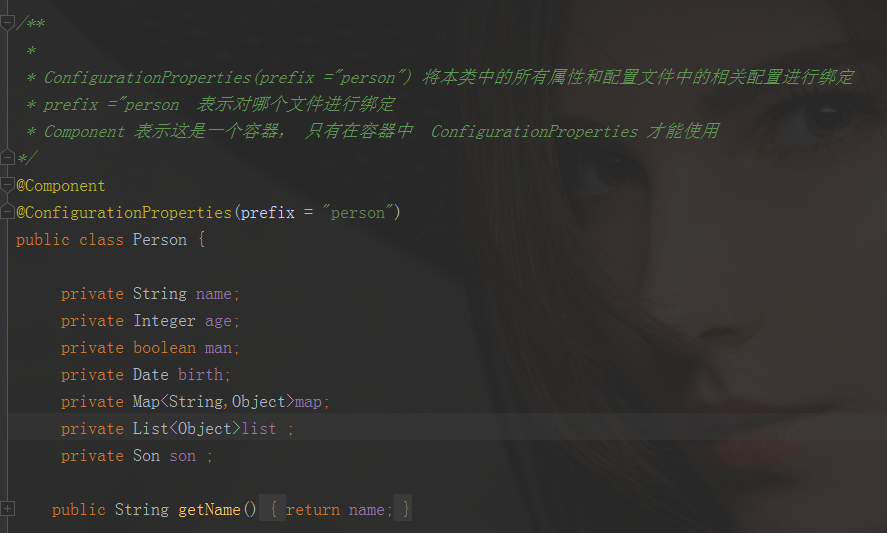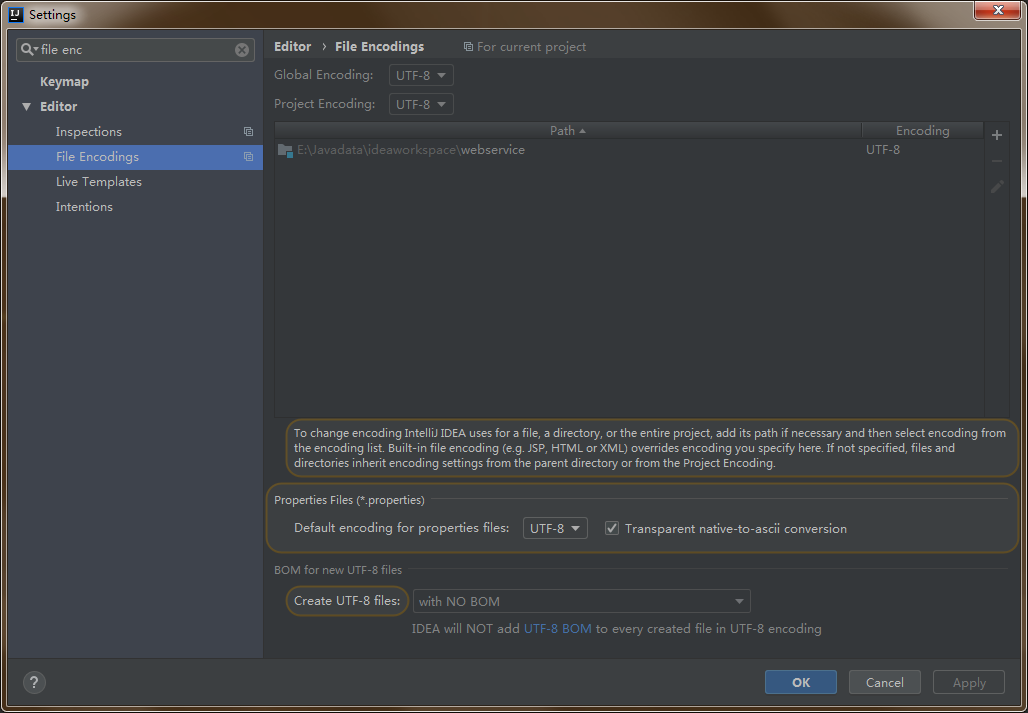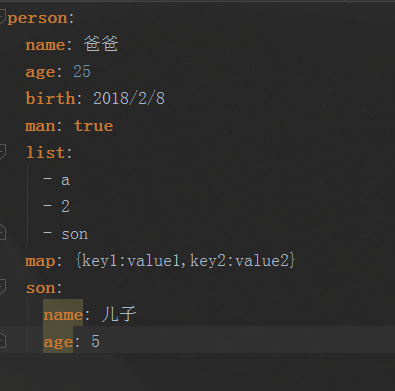从其他框架来看 我们都有自己的配置文件, hibernate有hbm,mybatis 有properties, 同样, Spring boot 也有全局配置文件。
Springboot使用一个全局的配置文件,而且配置文件的名字是固定的。 有两种
- application.properties
- application.yml
springboot 配置文件的作用是用来 修改SpringBoot自动配置的默认值;SpringBoot在底层都给我们自动配置好; 像我们Tomcat 启动 默认配置端口是8080 . 如果要修改, 我们就在这两个文件的一种中来修改,
YML (也叫YAML : YAM Ain't Markup Language)
YAML Ain't Markup Language 这是一个递归写法 ;
- YAML A Markup Language:是一个标记语言
- YAML isn't Markup Language:不是一个标记语言;
标记语言:
我们以前用的配置文件,大多都使用 xxxx.xml 文件 ;
YAML : 是一种以数据为中心的配置文件, 比json,xml 等更适合做配置文件
举个栗子:
以 修改端口为例 :
yml :
server:
port: 8081
xml :
<server>
<port>8081</port>
</server> xml 配置 将太多的浪费在了标签上面。
yml 基本语法:
k:(空格)v:表示一对键值对(空格必须有);
以 空格 的缩进来控制层级关系;只要是左对齐的一列数据,都是同一个层级的
server:
port: 8081
path: /hello属性和值也是大小写敏感;
值的写法:
字面量:普通的值(数字,字符串,布尔)
k: v:字面直接来写;
字符串默认不用加上单引号或者双引号;
"":双引号;不会转义字符串里面的特殊字符;特殊字符会作为本身想表示的意思
name: "zhangsan \n lisi":输出;zhangsan 换行 lisi
'':单引号;会转义特殊字符,特殊字符最终只是一个普通的字符串数据
name: ‘zhangsan \n lisi’:输出;zhangsan \n lisi
对象、Map(属性和值)(键值对):
k: v:在下一行来写对象的属性和值的关系;注意缩进
对象还是k: v的方式
friends:
lastName: zhangsan
age: 20
行内写法:
friends: {lastName: zhangsan,age: 18}
数组(List、Set):
用 - 值表示数组中的一个元素
pets:
- cat
- dog
- pig行内写法pets: [cat,dog,pig]
配置文件注入
javaBean :

可以导入配置文件处理器依赖,以后编写配置就会有代码提示;

代码展示配置文件注入属性值 :
1 package com.example.webservice.bean;
2
3 import org.springframework.boot.context.properties.ConfigurationProperties;
4 import org.springframework.stereotype.Component;
5
6 import java.util.Date;
7 import java.util.List;
8 import java.util.Map;
9
10 /**
11 *
12 * ConfigurationProperties(prefix ="person") 将本类中的所有属性和配置文件中的相关配置进行绑定
13 * prefix ="person 表示对哪个文件进行绑定
14 * Component 表示这是一个容器, 只有在容器中 ConfigurationProperties 才能使用
15 */
16 @Component
17 @ConfigurationProperties(prefix = "person")
18 public class Person {
19
20 private String name;
21 private Integer age;
22 private boolean man;
23 private Date birth;
24 private Map<String,Object>map;
25 private List<Object>list ;
26 private Son son ;
27
28 .....省略get/set 以及toString 方法
29
30 }
31
32
33 package com.example.webservice.bean;
34
35 public class Son {
36
37 private String name;
38 private Integer age ;
39
40 public String getName() {
41 return name;
42 }
43
44 public Integer getAge() {
45 return age;
46 }
47
48 public void setName(String name) {
49 this.name = name;
50 }
51
52 public void setAge(Integer age) {
53 this.age = age;
54 }
55
56 @Override
57 public String toString() {
58 return "Son{" + "name='" + name + '\'' + ", age=" + age + '}';
59 }
60 }
61
62
63 properties文件绑定的写法
64 #注释方法 Ctrl + /
65 person.name=爸爸
66 person.age=45
67 person.man=true
68 person.birth=2019/8/8
69 person.map.k1=h1
70 person.map.k2=h2
71 person.list=a,1,son
72 person.son.name=儿子
73 person.son,age=20
74
75
76 yml 文件绑定的写法:
77
78 person:
79 name: 爸爸
80 age: 25
81 birth: 2018/2/8
82 man: true
83 list:
84 - a
85 - 2
86 - son
87 map: {key1:value1,key2:value2}
88 son:
89 name: 儿子
90 age: 5测试类 : 在我们的test 文件夹下 :
package com.example.webservice;import com.example.webservice.bean.Person;import org.junit.Test;import org.junit.runner.RunWith;import org.springframework.beans.factory.annotation.Autowired;import org.springframework.boot.test.context.SpringBootTest;import org.springframework.test.context.junit4.SpringRunner;@RunWith(SpringRunner.class)@SpringBootTestpublic class WebserviceApplicationTests { @Autowired Person person; @Test public void contextLoads() { // 直接运行这个方法 ,而不是运行整个程序 System.out.println(person); System.out.println("********************************************************"); }
控制台打印结果 (使用的 yml 配置文件)

properties配置文件在idea中默认utf-8可能会乱码 。因为spring properties 默认是ASCII 码 ,所以需要将properties 默认编码改为UTP-8 ,再√上旁边的 将其运行时转换为ASCII码;再输入中文就好了

都改成utf-8 ,再输入中文就好了。
@Value获取值和@ConfigurationProperties获取值比较
| | @ConfigurationProperties | @Value |
| 功能 | 批量注入配置文件中的属性 | 一个个指定 |
| 松散绑定(松散语法) | 支持 | 不支持 |
| SpEL | 不支持 | 支持 |
| JSR303数据校验 | 支持 | 不支持 |
| 复杂类型封装 | 支持 | 不支持 |
配置文件yml还是properties他们都能获取到值;
如果说,我们只是在某个业务逻辑中需要获取一下配置文件中的某项值,使用@Value;
如果说,我们专门编写了一个javaBean来和配置文件进行映射,我们就直接使用@ConfigurationProperties;
配置文件注入值数据校验
@Component @ConfigurationProperties(prefix = "person") @Validated public class Person {
/** * <bean class="Person"> * <property name="name" value="字面量/${key}从环境变量、配置文件中获取值/#{SpEL}"></property> * <bean/> *///name必须是邮箱格式 @Email //@Value("${person.name}") private String name; //@Value("#{11*2}") private Integer age; //@Value("true") private Boolean boss; private Date birth; private Map<String,Object> maps; private List
@PropertySource&@ImportResource&@Bean
@PropertySource:加载指定的配置文件;
/**
* 将配置文件中配置的每一个属性的值,映射到这个组件中
* @ConfigurationProperties:告诉SpringBoot将本类中的所有属性和配置文件中相关的配置进行绑定;
* prefix = "person":配置文件中哪个下面的所有属性进行一一映射
*
* 只有这个组件是容器中的组件,才能容器提供的@ConfigurationProperties功能;
* @ConfigurationProperties(prefix = "person")默认从全局配置文件中获取值;
*
*/
@PropertySource(value = {"classpath:person.properties"})
@Component
@ConfigurationProperties(prefix = "person")
//@Validated
public class Person {
/**
* <bean class="Person">
* <property name="name" value="字面量/${key}从环境变量、配置文件中获取值/#{SpEL}"></property>
* <bean/>
*/
//name必须是邮箱格式
// @Email
//@Value("${person.name}")
private String name;
//@Value("#{11*2}")
private Integer age;
//@Value("true")
private Boolean boss;
```
@ImportResource:导入Spring的配置文件,让配置文件里面的内容生效;
Spring Boot里面没有Spring的配置文件,我们自己编写的配置文件,也不能自动识别;
想让Spring的配置文件生效,加载进来;就要将 @ImportResource 标注在一个配置类上
@ImportResource(locations = {"classpath:beans.xml"})//类路径上添加配置类的路径 导入Spring的配置文件让其生效 不来编写Spring的配置文件 ,下面这就是我们通常的Spring配置类文件
SpringBoot推荐给容器中添加组件的方式;推荐使用全注解的方式
1、配置类**@Configuration**------>Spring配置文件
2、使用@Bean给容器中添加组件 /**
- @Configuration:指明当前类是一个配置类;就是来替代之前的Spring配置文件
- 在配置文件中用
标签添加组件
*/ @Configuration public class MyAppConfig {
//将方法的返回值添加到容器中;容器中这个组件默认的id就是方法名 @Bean public HelloService helloService02(){ System.out.println("配置类@Bean给容器中添加组件了..."); return new HelloService(); }}
配置文件占位符
1、随机数
1 ${random.value}、${random.int}、${random.long}
2 ${random.int(10)}、${random.int[1024,65536]}
2、占位符获取之前配置的值,如果没有可以是用:指定默认值
1 properties
2 person.name=张三${random.uuid}
3 person.age=${random.int}
4 person.birth=2017/12/15
5 person.boss=false
6 person.maps.k1=v1
7 person.maps.k2=14
8 person.lists=a,b,c
// 如果没有hello这个属性, 则会直接输出
${person.hello} , 如果加了
${person.hello:hello}_dog 则会直接赋值 输出
hello_dog
9 person.dog.name=${person.hello:hello}_dog 10 person.dog.age=15
3、Profile
1、多Profile文件
我们在主配置文件编写的时候,文件名可以是 application-{profile}.properties/yml
springboot默认使用配置文件为application.properties;
所以我们在然后在application.properties配置文件中 激活自定义的环境配置文件就可以了从application.properties 加载到application-dev.properties 文件了
在配置文件中指定 spring.profiles.active=dev


2、yml支持多文档块方式
1 server:
2 port: 8081
3 spring:
4 profiles:
5 active: prod 表示当前激活使用哪个环境 --- 表示环境的分割 ,分成不同的文档块。
6 ---
7 server:
8 port: 8083
9 spring:
10 profiles: dev
11 ---
12 server:
13 port: 8084
14 spring:
15 profiles: prod #指定属于哪个环境
4、激活指定profile
1、在配置文件中指定 spring.profiles.active=dev
2、命令行:
java -jar spring-boot-02-config-0.0.1-SNAPSHOT.jar --spring.profiles.active=dev;
可以直接在测试的时候,配置传入命令行参数 ,打包好的项目运行的时候指定我们的环境:

3、虚拟机参数; 在运行的时候 选择Editor configrations


-Dspring.profiles.active=dev
5、配置文件加载位置
springboot 启动会扫描以下位置的application.properties或者application.yml文件作为Spring boot的默认配置文件
–file:./config/ 文件路径config目录--->最高优先级
–file:./ 文件路径根目录--->其次
–classpath:/config/ 类路径config目录--->再其次
–classpath:/ 类路径根目录--->最低优先级
优先级由高到底,高优先级的配置会覆盖低优先级的配置;
SpringBoot会从这四个位置全部加载主配置文件:互补配置;
我们还可以通过spring.config.location来改变默认的配置文件位置
项目打包好以后,我们可以使用命令行参数的形式,启动项目的时候来指定配置文件的新位置;指定配置文件和默认加载的这些配置文件共同起作用形成互补配置;
进入命令行 :
java -jar spring-boot-02-config-02-0.0.1-SNAPSHOT.jar --spring.config.location=G:/application.properties(properties的硬盘文件目录)
6、外部配置加载顺序
SpringBoot也可以从以下位置加载配置; 优先级从高到低;高优先级的配置覆盖低优先级的配置,所有的配置会形成互补配置
1.命令行参数
所有的配置都可以在命令行上进行指定
java -jar spring-boot-02-config-02-0.0.1-SNAPSHOT.jar --server.port=8087 --server.context-path=/abc
多个配置用空格分开; --配置项=值
2.来自java:comp/env的JNDI属性
3.Java系统属性(System.getProperties())
4.操作系统环境变量
5.RandomValuePropertySource配置的random.*属性值
由jar包外向jar包内进行寻找;
优先加载带profile
7.jar包外部的application-{profile}.properties或application.yml(带spring.profile)配置文件
8.jar包内部的application-{profile}.properties或application.yml(带spring.profile)配置文件
再来加载不带profile
9.jar包外部的application.properties或application.yml(不带spring.profile)配置文件
10.jar包内部的application.properties或application.yml(不带spring.profile)配置文件
11.@Configuration注解类上的@PropertySource
12.通过SpringApplication.setDefaultProperties指定的默认属性
所有支持的配置加载来源;
自动配置原理
配置文件到底能写什么?怎么写?自动配置原理;
1、**自动配置原理:
1)、SpringBoot启动的时候加载主配置类,开启了自动配置功能 ==@EnableAutoConfiguration==
2)、@EnableAutoConfiguration 作用:**
- 利用EnableAutoConfigurationImportSelector给容器中导入一些组件?
- 可以查看selectImports()方法的内容;
- List
SpringFactoriesLoader.loadFactoryNames()
扫描所有jar包类路径下 META-INF/spring.factories
把扫描到的这些文件的内容包装成properties对象
从properties中获取到EnableAutoConfiguration.class类(类名)对应的值,然后把他们添加在容器中
将 类路径下 META-INF/spring.factories 里面配置的所有EnableAutoConfiguration的值加入到了容器中;


```properties
# Auto Configure
org.springframework.boot.autoconfigure.EnableAutoConfiguration=\
org.springframework.boot.autoconfigure.admin.SpringApplicationAdminJmxAutoConfiguration,\
org.springframework.boot.autoconfigure.aop.AopAutoConfiguration,\
org.springframework.boot.autoconfigure.amqp.RabbitAutoConfiguration,\
org.springframework.boot.autoconfigure.batch.BatchAutoConfiguration,\
org.springframework.boot.autoconfigure.cache.CacheAutoConfiguration,\
org.springframework.boot.autoconfigure.cassandra.CassandraAutoConfiguration,\
org.springframework.boot.autoconfigure.cloud.CloudAutoConfiguration,\
org.springframework.boot.autoconfigure.context.ConfigurationPropertiesAutoConfiguration,\
org.springframework.boot.autoconfigure.context.MessageSourceAutoConfiguration,\
org.springframework.boot.autoconfigure.context.PropertyPlaceholderAutoConfiguration,\
org.springframework.boot.autoconfigure.couchbase.CouchbaseAutoConfiguration,\
org.springframework.boot.autoconfigure.dao.PersistenceExceptionTranslationAutoConfiguration,\
org.springframework.boot.autoconfigure.data.cassandra.CassandraDataAutoConfiguration,\
org.springframework.boot.autoconfigure.data.cassandra.CassandraRepositoriesAutoConfiguration,\
org.springframework.boot.autoconfigure.data.couchbase.CouchbaseDataAutoConfiguration,\
org.springframework.boot.autoconfigure.data.couchbase.CouchbaseRepositoriesAutoConfiguration,\
org.springframework.boot.autoconfigure.data.elasticsearch.ElasticsearchAutoConfiguration,\
org.springframework.boot.autoconfigure.data.elasticsearch.ElasticsearchDataAutoConfiguration,\
org.springframework.boot.autoconfigure.data.elasticsearch.ElasticsearchRepositoriesAutoConfiguration,\
org.springframework.boot.autoconfigure.data.jpa.JpaRepositoriesAutoConfiguration,\
org.springframework.boot.autoconfigure.data.ldap.LdapDataAutoConfiguration,\
org.springframework.boot.autoconfigure.data.ldap.LdapRepositoriesAutoConfiguration,\
org.springframework.boot.autoconfigure.data.mongo.MongoDataAutoConfiguration,\
org.springframework.boot.autoconfigure.data.mongo.MongoRepositoriesAutoConfiguration,\
org.springframework.boot.autoconfigure.data.neo4j.Neo4jDataAutoConfiguration,\
org.springframework.boot.autoconfigure.data.neo4j.Neo4jRepositoriesAutoConfiguration,\
org.springframework.boot.autoconfigure.data.solr.SolrRepositoriesAutoConfiguration,\
org.springframework.boot.autoconfigure.data.redis.RedisAutoConfiguration,\
org.springframework.boot.autoconfigure.data.redis.RedisRepositoriesAutoConfiguration,\
org.springframework.boot.autoconfigure.data.rest.RepositoryRestMvcAutoConfiguration,\
org.springframework.boot.autoconfigure.data.web.SpringDataWebAutoConfiguration,\
org.springframework.boot.autoconfigure.elasticsearch.jest.JestAutoConfiguration,\
org.springframework.boot.autoconfigure.freemarker.FreeMarkerAutoConfiguration,\
org.springframework.boot.autoconfigure.gson.GsonAutoConfiguration,\
org.springframework.boot.autoconfigure.h2.H2ConsoleAutoConfiguration,\
org.springframework.boot.autoconfigure.hateoas.HypermediaAutoConfiguration,\
org.springframework.boot.autoconfigure.hazelcast.HazelcastAutoConfiguration,\
org.springframework.boot.autoconfigure.hazelcast.HazelcastJpaDependencyAutoConfiguration,\
org.springframework.boot.autoconfigure.info.ProjectInfoAutoConfiguration,\
org.springframework.boot.autoconfigure.integration.IntegrationAutoConfiguration,\
org.springframework.boot.autoconfigure.jackson.JacksonAutoConfiguration,\
org.springframework.boot.autoconfigure.jdbc.DataSourceAutoConfiguration,\
org.springframework.boot.autoconfigure.jdbc.JdbcTemplateAutoConfiguration,\
org.springframework.boot.autoconfigure.jdbc.JndiDataSourceAutoConfiguration,\
org.springframework.boot.autoconfigure.jdbc.XADataSourceAutoConfiguration,\
org.springframework.boot.autoconfigure.jdbc.DataSourceTransactionManagerAutoConfiguration,\
org.springframework.boot.autoconfigure.jms.JmsAutoConfiguration,\
org.springframework.boot.autoconfigure.jmx.JmxAutoConfiguration,\
org.springframework.boot.autoconfigure.jms.JndiConnectionFactoryAutoConfiguration,\
org.springframework.boot.autoconfigure.jms.activemq.ActiveMQAutoConfiguration,\
org.springframework.boot.autoconfigure.jms.artemis.ArtemisAutoConfiguration,\
org.springframework.boot.autoconfigure.flyway.FlywayAutoConfiguration,\
org.springframework.boot.autoconfigure.groovy.template.GroovyTemplateAutoConfiguration,\
org.springframework.boot.autoconfigure.jersey.JerseyAutoConfiguration,\
org.springframework.boot.autoconfigure.jooq.JooqAutoConfiguration,\
org.springframework.boot.autoconfigure.kafka.KafkaAutoConfiguration,\
org.springframework.boot.autoconfigure.ldap.embedded.EmbeddedLdapAutoConfiguration,\
org.springframework.boot.autoconfigure.ldap.LdapAutoConfiguration,\
org.springframework.boot.autoconfigure.liquibase.LiquibaseAutoConfiguration,\
org.springframework.boot.autoconfigure.mail.MailSenderAutoConfiguration,\
org.springframework.boot.autoconfigure.mail.MailSenderValidatorAutoConfiguration,\
org.springframework.boot.autoconfigure.mobile.DeviceResolverAutoConfiguration,\
org.springframework.boot.autoconfigure.mobile.DeviceDelegatingViewResolverAutoConfiguration,\
org.springframework.boot.autoconfigure.mobile.SitePreferenceAutoConfiguration,\
org.springframework.boot.autoconfigure.mongo.embedded.EmbeddedMongoAutoConfiguration,\
org.springframework.boot.autoconfigure.mongo.MongoAutoConfiguration,\
org.springframework.boot.autoconfigure.mustache.MustacheAutoConfiguration,\
org.springframework.boot.autoconfigure.orm.jpa.HibernateJpaAutoConfiguration,\
org.springframework.boot.autoconfigure.reactor.ReactorAutoConfiguration,\
org.springframework.boot.autoconfigure.security.SecurityAutoConfiguration,\
org.springframework.boot.autoconfigure.security.SecurityFilterAutoConfiguration,\
org.springframework.boot.autoconfigure.security.FallbackWebSecurityAutoConfiguration,\
org.springframework.boot.autoconfigure.security.oauth2.OAuth2AutoConfiguration,\
org.springframework.boot.autoconfigure.sendgrid.SendGridAutoConfiguration,\
org.springframework.boot.autoconfigure.session.SessionAutoConfiguration,\
org.springframework.boot.autoconfigure.social.SocialWebAutoConfiguration,\
org.springframework.boot.autoconfigure.social.FacebookAutoConfiguration,\
org.springframework.boot.autoconfigure.social.LinkedInAutoConfiguration,\
org.springframework.boot.autoconfigure.social.TwitterAutoConfiguration,\
org.springframework.boot.autoconfigure.solr.SolrAutoConfiguration,\
org.springframework.boot.autoconfigure.thymeleaf.ThymeleafAutoConfiguration,\
org.springframework.boot.autoconfigure.transaction.TransactionAutoConfiguration,\
org.springframework.boot.autoconfigure.transaction.jta.JtaAutoConfiguration,\
org.springframework.boot.autoconfigure.validation.ValidationAutoConfiguration,\
org.springframework.boot.autoconfigure.web.DispatcherServletAutoConfiguration,\
org.springframework.boot.autoconfigure.web.EmbeddedServletContainerAutoConfiguration,\
org.springframework.boot.autoconfigure.web.ErrorMvcAutoConfiguration,\
org.springframework.boot.autoconfigure.web.HttpEncodingAutoConfiguration,\
org.springframework.boot.autoconfigure.web.HttpMessageConvertersAutoConfiguration,\
org.springframework.boot.autoconfigure.web.MultipartAutoConfiguration,\
org.springframework.boot.autoconfigure.web.ServerPropertiesAutoConfiguration,\
org.springframework.boot.autoconfigure.web.WebClientAutoConfiguration,\
org.springframework.boot.autoconfigure.web.WebMvcAutoConfiguration,\
org.springframework.boot.autoconfigure.websocket.WebSocketAutoConfiguration,\
org.springframework.boot.autoconfigure.websocket.WebSocketMessagingAutoConfiguration,\
org.springframework.boot.autoconfigure.webservices.WebServicesAutoConfiguration
```
View Code
每一个这样的 xxxAutoConfiguration类都是容器中的一个组件,都加入到容器中;用他们来做自动配置;
3)、每一个自动配置类进行自动配置功能;
4)、以HttpEncodingAutoConfiguration(Http编码自动配置)**为例解释自动配置原理;
@Configuration //表示这是一个配置类,以前编写的配置文件一样,也可以给容器中添加组件
@EnableConfigurationProperties(HttpEncodingProperties.class) //启动指定类的ConfigurationProperties功能;将配置文件中对应的值和HttpEncodingProperties绑定起来;并把HttpEncodingProperties加入到ioc容器中
@ConditionalOnWebApplication //Spring底层@Conditional注解(Spring注解版),根据不同的条件,如果满足指定的条件,整个配置类里面的配置就会生效; 判断当前应用是否是web应用,如果是,当前配置类生效
@ConditionalOnClass(CharacterEncodingFilter.class) //判断当前项目有没有这个类CharacterEncodingFilter;SpringMVC中进行乱码解决的过滤器;
@ConditionalOnProperty(prefix = "spring.http.encoding", value = "enabled", matchIfMissing = true) //判断配置文件中是否存在某个配置 spring.http.encoding.enabled;如果不存在,判断也是成立的
//即使我们配置文件中不配置pring.http.encoding.enabled=true,也是默认生效的;
public class HttpEncodingAutoConfiguration {
//他已经和SpringBoot的配置文件映射了
private final HttpEncodingProperties properties;
//只有一个有参构造器的情况下,参数的值就会从容器中拿
public HttpEncodingAutoConfiguration(HttpEncodingProperties properties) {
this.properties = properties;
}
@Bean //给容器中添加一个组件,这个组件的某些值需要从properties中获取
@ConditionalOnMissingBean(CharacterEncodingFilter.class) //判断容器没有这个组件?
public CharacterEncodingFilter characterEncodingFilter() {
CharacterEncodingFilter filter = new OrderedCharacterEncodingFilter();
filter.setEncoding(this.properties.getCharset().name());
filter.setForceRequestEncoding(this.properties.shouldForce(Type.REQUEST));
filter.setForceResponseEncoding(this.properties.shouldForce(Type.RESPONSE));
return filter;
}
```
根据当前不同的条件判断,决定这个配置类是否生效.
一但这个配置类生效;这个配置类就会给容器中添加各种组件;这些组件的属性是从对应的properties类中获取的,这些类里面的每一个属性又是和配置文件绑定的;
5)、所有在配置文件中能配置的属性都是在xxxxProperties类中封装者‘;配置文件能配置什么就可以参照某个功能对应的这个属性类
1 @ConfigurationProperties(prefix = "spring.http.encoding") //从配置文件中获取指定的值和bean的属性进行绑定
2 public class HttpEncodingProperties {
3
4 public static final Charset DEFAULT_CHARSET = Charset.forName("UTF-8");
精髓:
1)、SpringBoot启动会加载大量的自动配置类**
2)、我们看我们需要的功能有没有SpringBoot默认写好的自动配置类;**
3)、我们再来看这个自动配置类中到底配置了哪些组件;(只要我们要用的组件有,我们就不需要再来配置了)**
4)、给容器中自动配置类添加组件的时候,会从properties类中获取某些属性。我们就可以在配置文件中指定这些属性的值;
xxxxAutoConfigurartion:自动配置类;
给容器中添加组件
xxxxProperties:封装配置文件中相关属性;
2、细节
1、@Conditional派生注解(Spring注解版原生的@Conditional作用)
作用:必须是@Conditional指定的条件成立,才给容器中添加组件,配置配里面的所有内容才生效;
@Conditional扩展注解
作用(判断是否满足当前指定条件)
@ConditionalOnJava
系统的java版本是否符合要求
@ConditionalOnBean
容器中存在指定Bean
@ConditionalOnMissingBean
容器中不存在指定Bean
@ConditionalOnExpression
满足SpEL表达式指定
@ConditionalOnClass
系统中有指定的类
@ConditionalOnMissingClass
系统中没有指定的类
@ConditionalOnSingleCandidate
容器中只有一个指定的Bean,或者这个Bean是首选Bean
@ConditionalOnProperty
系统中指定的属性是否有指定的值
@ConditionalOnResource
类路径下是否存在指定资源文件
@ConditionalOnWebApplication
当前是web环境
@ConditionalOnNotWebApplication
当前不是web环境
@ConditionalOnJndi
JNDI存在指定项
自动配置类必须在一定的条件下才能生效;
我们怎么知道哪些自动配置类生效;
我们可以通过启用 debug=true属性;来让控制台打印自动配置报告==**,这样我们就可以很方便的知道哪些自动配置类生效;
1 =========================
2 AUTO-CONFIGURATION REPORT
3 =========================
4 Positive matches:(自动配置类启用的)
5 -----------------
6 DispatcherServletAutoConfiguration matched:
7 - @ConditionalOnClass found required class 'org.springframework.web.servlet.DispatcherServlet'; @ConditionalOnMissingClass did not find unwanted class (OnClassCondition)
8 - @ConditionalOnWebApplication (required) found StandardServletEnvironment (OnWebApplicationCondition)
9
10 Negative matches:(没有启动,没有匹配成功的自动配置类)
11 -----------------
12 ActiveMQAutoConfiguration:
13 Did not match:
14 - @ConditionalOnClass did not find required classes 'javax.jms.ConnectionFactory', 'org.apache.activemq.ActiveMQConnectionFactory' (OnClassCondition)
15 AopAutoConfiguration:
16 Did not match:
17 - @ConditionalOnClass did not find required classes 'org.aspectj.lang.annotation.Aspect', 'org.aspectj.lang.reflect.Advice' (OnClassCondition)













